Intel Core i5 3470 Review: HD 2500 Graphics Tested
by Anand Lal Shimpi on May 31, 2012 12:00 AM EST- Posted in
- CPUs
- Intel
- Ivy Bridge
- GPUs
HD 2500: Compute & Synthetics
While compute functionality could technically be shoehorned into DirectX 10 GPUs such as Sandy Bridge through DirectCompute 4.x, neither Intel nor AMD's DX10 GPUs were really meant for the task, and even NVIDIA's DX10 GPUs paled in comparison to what they've achieved with their DX11 generation GPUs. As a result Ivy Bridge is the first true compute capable GPU from Intel. This marks an interesting step in the evolution of Intel's GPUs, as originally projects such as Larrabee Prime were supposed to help Intel bring together CPU and GPU computing by creating an x86 based GPU. With Larrabee Prime canceled however, that task falls to the latest rendition of Intel's GPU architecture.
With Ivy Bridge Intel will be supporting both DirectCompute 5—which is dictated by DX11—but also the more general compute focused OpenCL 1.1. Intel has backed OpenCL development for some time and currently offers an OpenCL 1.1 runtime that runs across multiple generations of CPUs, and now Ivy Bridge GPUs.
Our first compute benchmark comes from Civilization V, which uses DirectCompute 5 to decompress textures on the fly. Civ V includes a sub-benchmark that exclusively tests the speed of their texture decompression algorithm by repeatedly decompressing the textures required for one of the game’s leader scenes. And while games that use GPU compute functionality for texture decompression are still rare, it's becoming increasingly common as it's a practical way to pack textures in the most suitable manner for shipping rather than being limited to DX texture compression.
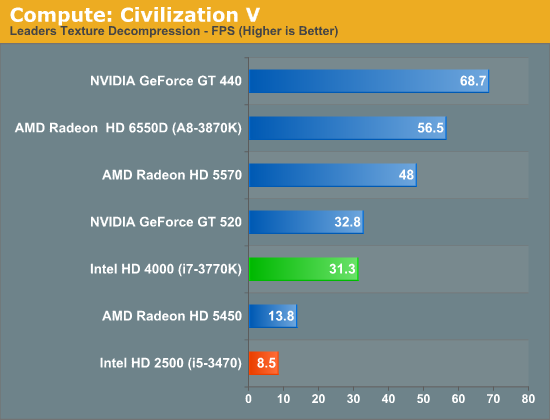
These compute results are mostly academic as I don't expect anyone to really rely on the HD 2500 for a lot of GPU compute work. With under 40% of the EUs of the HD 4000, we get under 30% of the performance from the HD 2500.
We have our second compute test: the Fluid Simulation Sample in the DirectX 11 SDK. This program simulates the motion and interactions of a 16k particle fluid using a compute shader, with a choice of several different algorithms. In this case we’re using an (O)n^2 nearest neighbor method that is optimized by using shared memory to cache data.
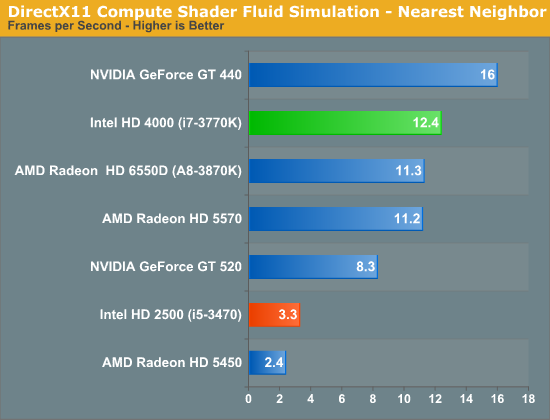
Thanks to its large shared L3 cache, Intel's HD 4000 did exceptionally well here. Thanks to its significantly fewer EUs, Intel's HD 2500 does much worse by comparison.
Our last compute test and first OpenCL benchmark, SmallLuxGPU, is the GPU ray tracing branch of the open source LuxRender renderer. We’re now using a development build from the version 2.0 branch, and we’ve moved on to a more complex scene that hopefully will provide a greater challenge to our GPUs.
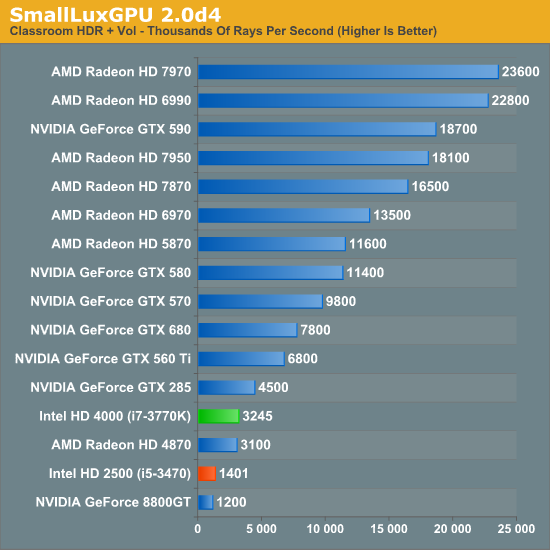
Intel's HD 4000 does well here for processor graphics, delivering over 70% of the performance of NVIDIA's GeForce GTX 285. The HD 2500 takes a big step backwards though, with less than half the performance of the HD 4000.
Synthetic Performance
Moving on, we'll take a few moments to look at synthetic performance. Synthetic performance is a poor tool to rank GPUs—what really matters is the games—but by breaking down workloads into discrete tasks it can sometimes tell us things that we don't see in games.
Our first synthetic test is 3DMark Vantage’s pixel fill test. Typically this test is memory bandwidth bound as the nature of the test has the ROPs pushing as many pixels as possible with as little overhead as possible, which in turn shifts the bottleneck to memory bandwidth so long as there's enough ROP throughput in the first place.
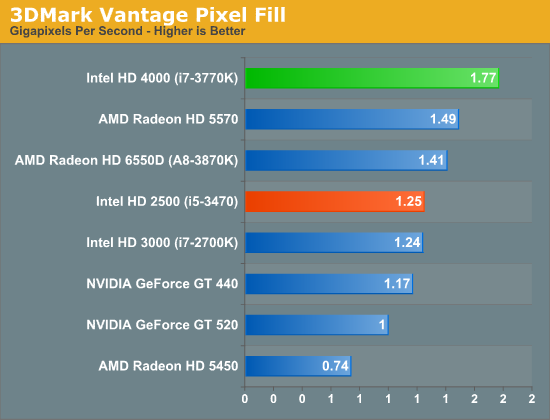
It's interesting to note here that as DDR3 clockspeeds have crept up over time, IVB now has as much memory bandwidth as most entry-to-mainstream level video cards, where 128bit DDR3 is equally common. Or on a historical basis, at this point it's half as much bandwidth as powerhouse video cards of yesteryear such as the 256bit GDDR3 based GeForce 8800GT.
Moving on, our second synthetic test is 3DMark Vantage’s texture fill test, which provides a simple FP16 texture throughput test. FP16 textures are still fairly rare, but it's a good look at worst case scenario texturing performance.
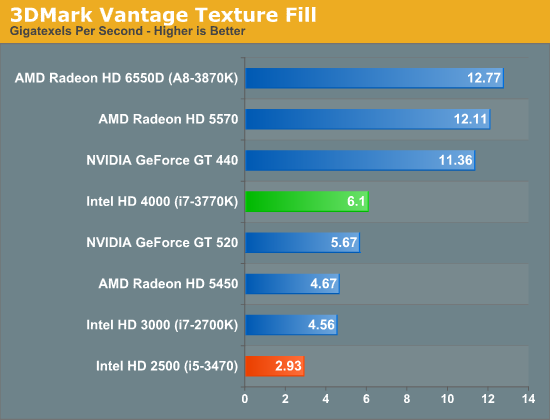
Our final synthetic test is the set of settings we use with Microsoft’s Detail Tessellation sample program out of the DX11 SDK. Since IVB is the first Intel iGPU with tessellation capabilities, it will be interesting to see how well IVB does here, as IVB is going to be the de facto baseline for DX11+ games in the future. Ideally we want to have enough tessellation performance here so that tessellation can be used on a global level, allowing developers to efficiently simulate their worlds with fewer polygons while still using many polygons on the final render.
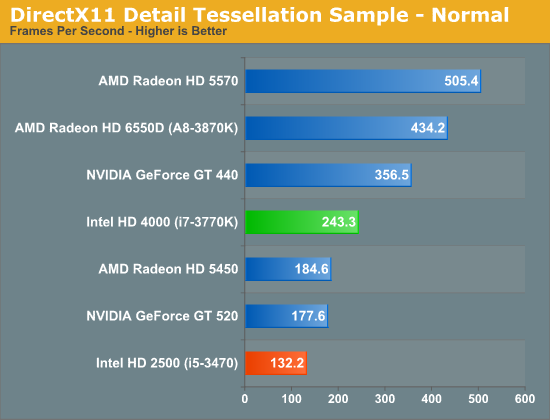
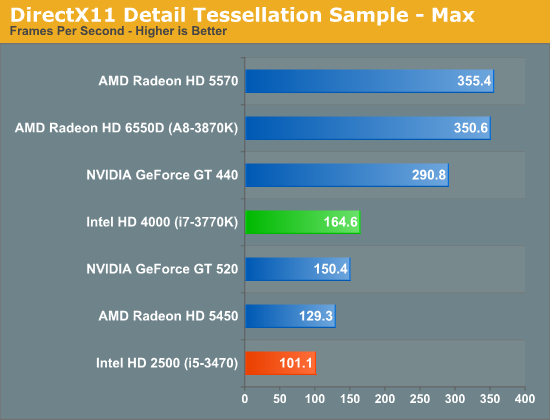
The results here are as expected. With far fewer EUs, the HD 2500 falls behind even some of the cheapest discrete GPUs.
GPU Power Consumption
As you'd expect, power consumption with the HD 2500 is tangibly lower than HD 4000 equipped parts:
| GPU Power Consumption Comparison under Load (Metro 2033) | ||||
| Intel HD 2500 (i5-3470) | Intel HD 4000 (i7-3770K) | |||
| Intel DZ77GA-70K | 76.2W | 98.9W | ||
Running our Metro 2033 test, the HD 4000 based Core i7 drew nearly 30% more power at the wall compared to the HD 2500.










67 Comments
View All Comments
JarredWalton - Thursday, May 31, 2012 - link
Intel actually has a beta driver (tested on the Ultrabook) that improves Portal 2 performance. I expect it will make its way to the public driver release in the next month. There are definitely still driver performance issues to address, but even so I don't think HD 4000 has the raw performance potential to match Trinity unless a game happens to be CPU intensive.n9ntje - Thursday, May 31, 2012 - link
Don't forget memory bandwidth. Both the CPU and GPU use the same memory on the motherboard.tacosRcool - Thursday, May 31, 2012 - link
kinda a waste in terms of graphicsparaffin - Thursday, May 31, 2012 - link
With 1920×1080 being the standard thesedays I find it annoying that all AT tests continue to ignore it. Are you trying to goad monitor makers back into 16:10 or something?Sogekihei - Monday, June 4, 2012 - link
The 1080p resolution may have become standard for televisions, but it certainly isn't so for computer monitors. These days the "standard" computer monitor (meaning, what an OEM rig will ship with in most cases whether it's a desktop or notebook) is some variant of 136#x768 resolution, so that gets tested for low-end graphics options that are likely to be seen in cheap OEM desktops and most OEM laptops (such as integrated graphics seen here.)The 1680x1050 resolution was the highest end-user resolution available cheaply for a while and is kind of like a standard among tech enthusiasts- sure you had other offerings available like some (expensive) 1920x1200 CRTs, but most people's budget left them with sticking to 1280x1024 CRTs or cheap LCDs or if they wanted to go with a slightly higher quality LCD practically the only available resolution at the time was 1680x1050. A lot of people don't care enough about the quality of their display to upgrade it as frequently as performance-oriented parts so many of us still have at least one 1680x1050 lying around, probably in use as a secondary or for some even a primary display despite 1080p monitors being the same cost or lower price when purchased new.
Beenthere - Thursday, May 31, 2012 - link
I imagine with the heat/OC'ing issues with the trigate chips, Intel is working to resolve Fab as well as operational issues with IB and thus isn't ramping as fast as normal.Fritsert - Thursday, May 31, 2012 - link
Would the HQV score of the HD2500 be the same as the HD4000 in the Anandtech review? Basically would video playback performance be the same (HQV, 24fps image enhancement features etc.)?A lot of processors in the low power ivy bridge lineup have the HD2500. If playback quality is the same this would make those very good candidates for my next HTPC. The Core i5 3470T specifically.
cjs150 - Friday, June 8, 2012 - link
Also does the HD2500 lock at the correct FPS rate which is not exactly 24FPS. AMD has had this for ages but Intel only caught up with the HD4000. For me it is the difference between an i7-3770T and an i5-3470TAffectionate-Bed-980 - Thursday, May 31, 2012 - link
This is a replacement of the i5-2400. Actually the 3450 was, but this is 100mhz faster. You should be comparing HD2000 vs HD2500 as well as these aren't top tier models with the HD3000/4000.bkiserx7 - Thursday, May 31, 2012 - link
In the GPU Power Consumption comparison section, did you disable HT and lock the 3770k to the same frequency as the 3470 to get a more accurate comparison between just the HD 4000 and HD 2500?